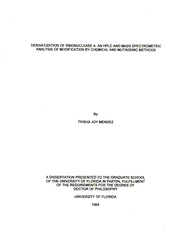
Derivatization of Ribonuclease A : an HPLC and mass spectrometric analysis of modification by chemical and mutagenic methods PDF
Preview Derivatization of Ribonuclease A : an HPLC and mass spectrometric analysis of modification by chemical and mutagenic methods
DERIVATIZATIONOFRIBONUCLEASEA:ANHPLCANDMASSSPECTROMETRIC ANALYSISOFMODIFICATIONBYCHEMICALANDMUTAGENICMETHODS By TRISHAJOYMtzNDEZ ADISSERTATIONPRESENTEDTOTHEGRADUATESCHOOL OFTHEUNIVERSITYOFFLORIDAINPARTIALFULFILLMENT OFTHEREQUIREMENTSFORTHEDEGREEOF DOCTOROFPHILOSOPHY UNIVERSITYOFFLORIDA 1999 AKNOWLEDGEMENTS MytimespentattheUniversityofFloridawillalwaysrepresentformearather remarkabletimeinmylife. Manypeoplehavecontributedtomakingthetimevaluable, notonlywithregardtothewell-roundededucationIhavereceivedbutalsothe memoriesthathavebeencreated. Iwishtoaddressthosewhohaveputagreatdealof effortintomyendeavors. Noeducationispossiblewithoutanenvironmentinwhichtoflourish. Therefore,I wouldliketothanktheestablishment,theUniversityofFlorida,theGraduateSchool, CollegeofLiberalArtsandSciencesandtheDepartmentofChemistryforallowingmeto joinandleamwithinthisinstitution. SpecificallyIacknowledgethestipendandtuition waiversIreceivedaswellastravelfunds,andIamgratefulforthisfinancialsupport. Iwishtothankallthosewhohavebeenmycolleaguesinonecapacityor another. Ishallstartwiththosehaveworkedwithmedayinanddayout,theRichardson researchgrouppastandpresent. Ithasbeenapleasuretoworkwithandgettoknow KenWeakley,CelesteRegino,DeonBennett,LindaNichols,HuirongYao,ChengXu, JerroldMillerandMattRyan.Eachpersonhasenlivenedandaddedanimportant dimensiontothefriendlyatmosphereoftheRichardsonresearchlabs. Iwillmissthese friends. IspecificallyacknowledgeCelesteReginoforthesynthesisoftheDPAligands andforaidinthecouplingreactions,andIamgratefultoLindaNicholsforthe acquisitionofallESI/FTICR-MSdatapresentedhere. Iwishtothankthosepeopleinthemassspectrometryserviceslabwhohave becomerespectedcolleagues:Dr.DavidPowellandDr.JodieJohnson. IthankDr. a PowellfortheacquisitionoftheMALDI/TOF-MSdatapresentedinthisdissertation,his muchappreciatededitingskillsforthepreparationofthismanuscriptaswellashis financialsupport. IamgratefultoJodiefortheacquisitionofallHPLC/ESI/QIT-MSdata presented. IalsothankJodieforhisgreatideas,smilingface,qualityofcharacterand abilitytolistenthathavemadeourfriendshipofhighestvaluetome. Ialsomustthank Dr.NancyDenslowfortheuseoftheMALDI/TOF-MSintheICBRProteinCoreandfor heradviceinproteinchemistry. IwanttothankthepeopleintheBennergroupwhohavecontributedtomy effortsindifferentways. LeeRaleyhasperformedasignificantamountofworkforthe creationofthemutantRNaseAandtaughtmewhatIknowaboutproteinexpression. StefanLutzhasbeenacolleaguebeyondcomparefromtheverybeginning. From classestoqualifyingexamstopracticingforpresentations,ithasbeenmygoodfortune tohaveStefanasmyclassmateandfriend. Dr.StevenBennerhasbeengenerousin hissharingofequipmentformyresearchandenlighteningasateacher,oneIhopeto neverforget. Icannotforgetthepeoplewhomakethebureaucracyofschoolmucheasierto navigate:allthoseinthechemistryfiscaloffice,thegraduatecoordinator’sofficeandthe inorganicdivisionaloffices,especiallyAmandaGarriguesandMaribelLisk. MytimeatUFwouldneverhavebeenasenjoyableasitwasifnotforthe friendshipsofmany,includingPerlaSklar,JuliaRusak,LindaNichols,andmost importantlyJenniferTonzello. Thesewomenwillbelifelongfriends. Mydeepappreciationgoestomyresearchadvisor,ProfessorDavidRichardson. Davehashelpedmebecomeabetterresearcher,improvemywritingskillsandleam howtothickenmyskin,allskillsthatwillimprovemyprofessionalfuture. Theareasin whichandthesheervolumeofinformationIlearnedfromDavecannotbedescribed here. LetitbesufficientthatIsayIamtrulygratefulforhiseffortsasanadvisor. Finally,myheartfeltthanksgoestomyimmediatefamily,whoseloveformehas madepossibleeverythinggoodinmylife. Mymother,Lora,hasbeenmybiggest cheerleaderandmosthelpfulfriend. Hercourageandworkethichavebeenthebest exampleofawomantobeemulated. Myson,Alexander,hasmademeamoreefficient student,butmoreimportantlyhispresencehastaughtmegratitudeforthingsmost importantinlife. Myhusband,Edras,hasbeenmypartnerandfriendforlongerthanI canremember. Hiscontributionstomylifeseeminseparablefrommyown,andthe workpresentedhereisjustoneofmanyendeavorsthatwouldnotbepossiblewithout hisunconditionallove. MostimportantlyIthankthegoodLordforHisabundantgrace. IV TABLEOFCONTENTS page ACKNOWLEDGMENTS ABSTRACT 3 CHAPTERS 1 INTRODUCTION 4 ChemicalModificationofProteins ElectrosprayMassSpectrometry ESI-MSApplicationstoProteinCharacterization ESI-MSforAnalysisofChemicalModificationsandBioconjugation 5 inProteins 2 CHEMICALMODIFICATIONOFRIBONUCLEASEA Introduction 30 ExperimentalProcedures 36 ResultsandDiscussion... 41 Conclusions 66 THEMAPPINGOFSMPT-MODIFIEDRNASEAI:PROTEOLYTICDIGESTION WITHTRYPSINANDESI/FTICR-MSANALYSIS 69 Introduction ExperimentalProcedures 74 ResultsandDiscussion 77 Conclusions ®7 THEMAPPINGOFSMPT-MODIFIEDRNASEAII:PROTEOLYTICDIGESTION WITHSUBTILISINANDHPLC/ESI/QIT-MSANDMSnANALYSIS 88 Introduction ExperimentalProcedures 9^ CReosnuclltussiaonndsDiscussion ^933 BIOCONJUGATIONOFRNASEATOASYNTHETICCOFACTOR: PRELIMINARYWORK v 9 Introduction 114 ExperimentalProcedures 11 ResultsandDiscussion 123 Conclusions 129 6 GENERALCONCLUSIONS 132 APPENDIX 138 LISTOFREFERENCES 144 BIOGRAPHICALSKETCH 160 vi AbstractofDissertationPresentedtotheGraduateSchool oftheUniversityofFloridainPartialFulfillmentofthe RequirementsfortheDegreeofDoctorofPhilosophy DERIVATIZATIONOFRIBONUCLEASEA:ANHPLCANDMASSSPECTROMETRIC ANALYSISOFMODIFICATIONBYCHEMICALANDMUTAGENICMETHODS By TrishaJoyM6ndez December1999 Chairman:ProfessorDavidE.Richardson MajorDepartment:Chemistry Chemicalmodificationofproteinsisademonstratedmethodforincorporating newligandsintoanenzymethroughthereactionofresiduesidechainswithvarious chemicalreagents. Reactionofanenzymeresiduewithamodifyingreagentthat incorporatesaligandofinteresttothesystemresultsinpotentialnovelchemicalactivity oftheenzyme,creatingabioconjugate. Abioanalyticalmethodforthedevelopmentand characterizationofabaseproteinsystemtobeusedasabioconjugateispresented. ThemodificationofribonucleaseAwiththeheterobifunctionalcross-linker,4- succinimdyloxycarbonyl-methyl-a-[2-pyridyldithio]-toluene(SMPT),isdescribed. RNase Ahas11sitesofpotentialmodificationbytheSMPTreagent. Trackingthe2- dimensionalseparationandproteolyticdigestionofSMPT-modifiedRNaseAwith ESI/FTICR-MSandHPLC/ESI/QIT-MSdemonstratesthedetailedinformationaboutthe numberofSMPTmodificationsandsitesofmodificationthatcanbeobtainedby applicationofthesetechniques.AnalysisofnativeandmodifiedRNaseAtrypticdigests byESI/FTICR-MSresultedintheidentificationofthesitesofmodification. Semi- vii quantitativeresultsofthereactivityofcertainlysineresiduestowardthecouplingreagent SMPTarepossible.Twosites(lysines1and37)arehighlyreactive,whilethreesites (lysines41,61and104)appeartobeunreactiveundertheconditionsused. Digestion ofthemodifiedandunmodifiedRNaseAbysubtilisinfollowedbyexaminationwith HPLC/ESI/QIT-MSresultedinthequantificationofthepropensityofsubtilisintocleave RNaseAandSMPT-modifiedRNaseAatvariouspeptidelinkages,whichhasnotbeen previouslydemonstrated. HPLC/ESI/QIT-MSandMS"enabledfurtherinvestigationof modificationonlysines1and7,includingmodificationatthes-anda-aminopositionson lysine1. CouplingofsinglymodifiedRNaseAtoasyntheticcofactorofinterest,2,2’- dipyridylamine,isdemonstratedasanexampleoftheassemblyofthebioconjugate. ThecomplementtochemicalmodificationofRNaseAforthedevelopmentofa systemforbioconjugationissite-directedmutagenesis. Preliminaryworkonthe characterizationandcouplingofthemutatedRNaseA(F8C)usingMALDI/TOF-MSis presented. viii CHAPTER1 INTRODUCTION ChemicalModificationofProteins Thechemicalmodificationofproteinsisausefultoolfortheelucidationof informationmostbasictoenzymechemistry,thatis,theunderstandingofsubstrate bindingandsubsequentbimolecularcatalysis. Therationaldesignofchemicalmodifiers hasenabledstructuralinformationaboutproteinsandenzymestobeobtainedpriorto themodemtechniquesofX-raycrystallographyandnuclearmagneticresonance(NMR) spectrometry. Byintroducingnewchemicalgroupsintoaproteinviacovalent interaction,informationcanbelearnedaboutthechemicalnatureandrelativereactivities oftheaminoacidsthatarepresent. Residuesmostsusceptibletochemicalmodification arelysineandarginineattheirnucleophilice-animogroups,tyrosineatitshydroxy group,cysteineatitssulfhydrylgrouporcross-linkeddisulfide,histidineatitsimidazole group,tryptophanatitsindolegroup,glutamicacidandasparticacidattheircarboxylic acids,theN-terminalamino,andC-terminalcarboxylgroups. Duetothedifferencesin thechemicalnatureofthesegroups,theirreactivitiesvarywithdifferentchemical modifiers,changingpH,andbuffercomposition(1-3). Exploitationofthesechemical differencesthroughchemicalmodificationhasresultedinthousandsofpublications demonstratingstructuralandfunctionalinformationforproteins. Anoverviewof researchexamplesispresentedhereillustratingnotonlytheevolutionofchemical modificationasastandardtoolfortheinvestigationofproteinsbutalsocreative expansionstothebasicchemicalmodificationsfortheaccomplishmentofinnovative researchgoals. 1 2 Oneofthefirstcomprehensivechemicalmodificationstudieswasdemonstrated in1948,byFraenkel-Conratetal.(4). Theseresearchersinvestigatedtheprotease trypsin,itsinhibitor,ovomucoidandthemodeofinteractionbetweenthetwothrough chemicalmodification. Aseriesofchemicalderivatizationswereperformedontrypsin andovomucoidincludingacetylation,esterification,epoxidation,reduction,couplingwith diazobenzenesulfonicacid,iodination,andsoon. Suchmodificationsresultedinthe determinationthattrypsininteractswithasubstratethroughgroupsotherthanitsamino groupsbutcombinesthroughitsaminogroupswiththeacidgroupsoftheinhibitor, ovomucoid. Astabilizationrolewasassignedtotheotherimportantresiduesintrypsin. Fraenkel-Conratetal.(5)usedchemicalmodificationagainin1950toprobethe iron-bindingcapabilityofconalbumin,anenzymefoundineggwhites. Itwasreported thatallchemicalmodificationsperformedinthisresearch,includingacetylation, iodinationorcouplingofphenolicacidandimidazolegroups,substitutionofamideof guanidylgroupsanddisulfidereduction,resultedininactivationofiron-bindingcapability, demonstratingthecomplexityoftheinteractionsrequiredformetal-binding. Analytical techniquesavailableatthattimedidnotallowfurtherinformationtobeextractedfrom thechemicalmodificationresults,despitetheunderstandingofthechemistryinvolvedin themodifications. In1962,ageneralmethodforcovalentmodificationofactivesiteresidueswas presentedbyWofsyeta/.(6). Eventhoughthespecificexampleusedtodemonstrate thetheorywasanantibody,itsdirectapplicationtoenzymeswasclear.Themethod, termedaffinitylabeling,madeuseofamodificationreagentthatisdesignedtohavean affinityforaspecificsiteontheprotein. Onceboundbynon-covalentinteractions,the reagentandproteinundergoachemicalreactiontocovalentlybindthereagentorpartof thereagenttotheproteinintheselectedsite. However,itwasnotedthat“...conclusive proofthatlabelingoftheactivesitehadoccurredcouldonlybeachievedthroughthe
